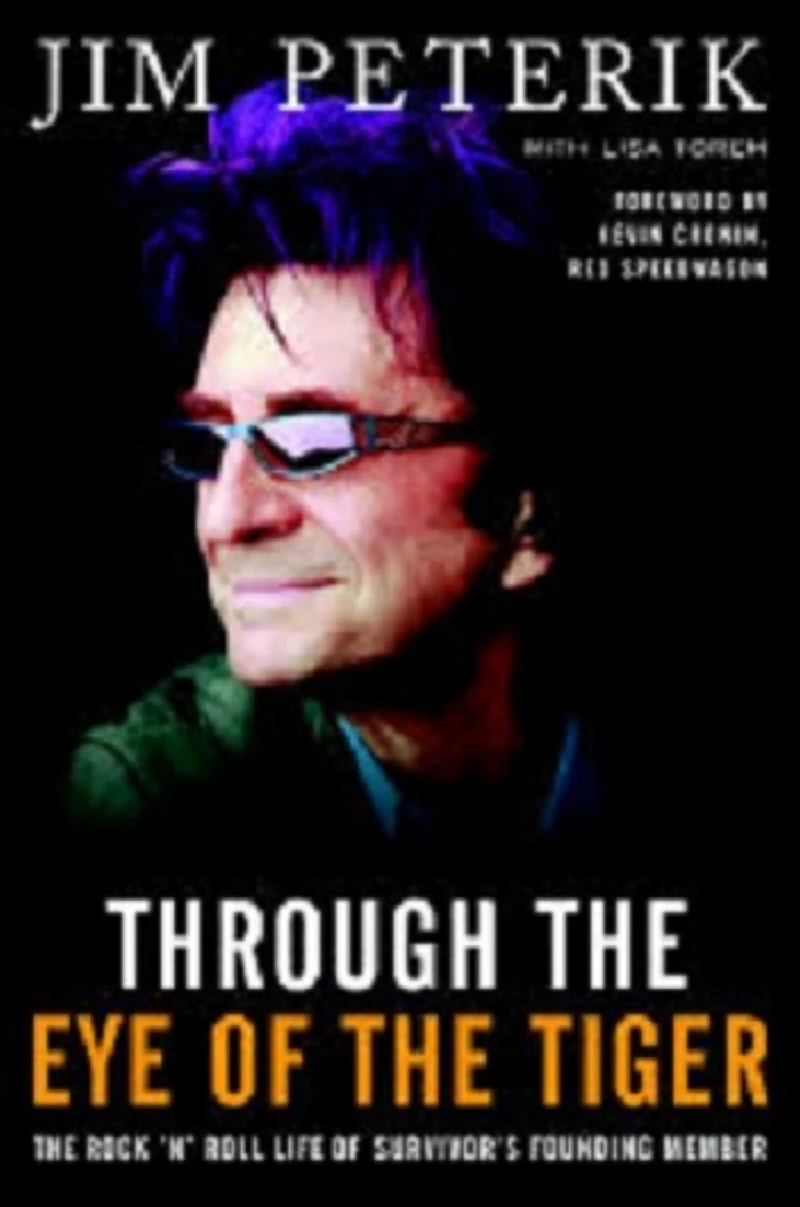Lisa Torem - Interview
by John Clarkson
published: 9 / 2 / 2015

intro
John Clarkson talks to our own writer Lisa Torem about ghost writing music legend, Survivor star and 'Eye of the Tiger' co-writer Jim Peterik's new autobiography
Singer-songwriter and multi-instrumentalist Jim Peterik met with worldwide success in 1983 when his band Survivor had a worldwide number one hit in 1983 with 'Eye of the Tiger', which they recorded for the soundtrack of the Sylvester Stallone film, 'Rocky III'. Peterik, who was brought up in the working class Illinois small city of Berywn, the son of a telephone engineer, first attracted fame as a teenager, when his high school band the Ides of March had a hit with their early single, 'You Wouldn't Listen', in 1966. The group subsequently went on to have an American no. 2 hit with the bestselling 'Vehicle', but broke up in 1973. After 'Eye of the Tiger', Survivor also has a second international hit with 'Burning Heart', which appeared on the soundtarck for the 1985 film, 'Rocky IV'. Peterik has also co-written songs with the Beach Boys, the Doobie Brothers, REO Speedwagon, Cheap Trick, Sammy Hagar and .38 Special, and continues to play shows with the Ides of March, who reformed after a seventeen year absence in 1990 with their original line-up. Jim Peterik has recently published his autobiography, 'Through the Eye of the Tiger', which he co-wrote with Pennyblackmusic writer Lisa Torem whom he met after she interviewed him for this website. For all of his encounters with the likes of Led Zeppelin, The Beach Boys, and, of course, Sylvester Stallone, Jim Peterik remains resilently down to earth in 'Through the Eye of the Tiger' and refreshingly aware of his roots. It is a fascinating, revealing and riotously entertaining book from a musical legend. We spoke to Lisa Torem about working with Peterik and the art of "ghost writing." PB: In the UK we know Jim Peterik mainly for 'Eye of the Tiger' and to a lesser degree 'Burning Heart’. In America he had several more hits and number ones both with the Ides of March and Survivor. He left Survivor, which carries on, in a different incarnation in the late 1990s. How highly regarded and well known is he these days in both America and across his native Illinois? LT: Jim has always got multiple projects going on. With World Stage, an annual concert series he created, he performs with and showcases other songwriters and performers and this event sells out quickly. That said, people in the Chicago area and the outlying suburbs know they can touch base with Jim, his material and colleagues when World Stage occurs. Jim owns his own recording studio and produces and mentors other acts. A lot of his clients know each other and their fan bases often intersect. With the Ides of March, Jim performs holiday shows and general shows around town frequently and the band travels nationally, as well. Jim makes frequent trips to Nashville and is well known and well established in the songwriting community there. I believe he was asked to perform in China not too long ago. His influence is far-reaching, yet there are many people who recognize 'Eye of the Tiger' but don’t match the song up with Jim’s name. I believe the book will change all of that. PB: He invited you to co-write his autobiography with him after you had interviewed him for Pennyblackmusic. How quickly after that did he get in touch with you? It must have at first seemed very strange and surreal. LT: Well, because it happened in baby steps, it wasn’t as surreal as you might think. The funny thing is, though, I thought I would be speaking with Jim by phone for our initial interview. As luck would have it, and because he has a generous spirit, he invited me to interview him at his home studio Lennon’s Den, and to stick around and watch him record some tracks and then grab some lunch. I had had a lot of fun researching his vast catalogue, and, since he was willing to talk for more than the expected twenty minutes, we ended up with a lot of content. I was intrigued with his skills as a writer and the way he seemingly whisked ideas out of thin air. Not many people can claim that ability and not many can keep the process going for decades. His themes included the famed Scottish destiny stone and peace rallies in Spain. He keeps up with current events, and seems to enjoy studying mythology and world history. He’s created some evocative imagery from nature too. Jim had mentioned that he was considering writing a memoir but he didn’t bring it up again for, I believe, several months. When he asked me directly, I felt very strongly that I would really enjoy helping to tell his story. Besides, I felt an immediate kinship. We’re both Midwesterners, we both had musician fathers, and Jim reminded me of people from my old neighbourhood because he is very direct and unpretentious. PB: Jim had his first national hit with ‘You Wouldn’t Listen’ in 1966 as a sixteen year old and with the Ides of March. Why do you think he has been able to maintain it a nearly fifty year long career when so many other talented musicians have not been so successful? Do you think that has just been lucky or do you think there is more to it than that? LT: I think Jim is extremely focused and thinks ahead when it comes to planning album projects or collaborations. He ha a lot of contacts and people on his team who will go the extra mile, whether that means working on production, helping to find the perfect vocalist or lead guitarist for a project or creating a related video. He is open to new, musical ideas—for example, after discovering a love for smooth jazz, he wrote lyrics for Acoustic Alchemy instrumentals, which reflected those newfound passions and created alliances with that popular act. That said, I can’t imagine Jim going into a contemporary genre just for the heck of it—we all know artists that felt pressured to shift gears in that way and it didn’t come off—I’d be surprised to see him produce rap or hip hop because he’s so driven by melody—I can’t see him launching a bluegrass project without having the personnel or the background (of course, you never know!) but when a style or theme appeals to him, he embraces it. PB: He makes much in the book of family values, and, while ‘Through the Eye of Tiger’ has plenty of rock and roll, he has managed to almost entirely avoid much of the sex and drugs of the business. There is a story in it about the Ides of March being invited to one of Led Zeppelin’s infamous parties, staying for two minutes, deciding it was not for them and scarpering. Do you think having that strong family base has also been a factor in that success and its longevity? LT: I do. I think coming from a strong community and having a secure place within his family structure was a blessing. He shares the Zeppelin story with young people a lot to show them that you don’t have to be a follower and that one can achieve success without succumbing to alcohol and drugs. He has a strong marriage and I believe he is proud of that. His parents stayed together through thick and thin—maybe that was a factor, too, in working through any issues in his own relationship. Gene Simmons, Frank Zappa—there are and have been other artists who took note of addictive behaviours and steered clear of them, but the stories of the lost weekends tend to garner more press. PB: Writing books with and hanging out with rock stars might be seen as being very glamorous, but the reality is that if you are going to do it properly it is very hard work. What was the most difficult thing about writing the book? LT: It can, indeed, be a challenge to work on a project of this scale. It’s not just a matter of chronology; it goes way beyond that. Imagine if you were going to write your own story. Where do you start? Which version of a story do you include? Jim, for example, had some wonderful courtship stories about his early days with his then-girlfriend Karen Moulik. (Jim and Karen Peterik are still happily married). I really enjoyed these stories even though Jim put a different twist on them each time and that’s what made the process enjoyable, but still, which version gets chosen? How much do you want to share with strangers or friends for that matter? There were parts of the book that ultimately had to be chopped and it was difficult to say goodbye to some of those passages, but it’s important to always keep the whole picture in mind. Then there are the usual culprits: fact checking, revising, consolidating, sequencing…it’s hard to explain unless you’ve been through the process, but some of it involves imagination and some of it is, as you suggest, comes down to simply hard work. We began with about fifty recorded conversations and then Jim began writing his thoughts down. Transitions can be tricky. PB: What was the best thing about working on the book? I loved the Ides of March and Survivor slice-of-life tales: communing in a broken-down van and praying they’d make the next gig despite inclement weather, performing at the one-off Budokan in Tokyo; the aforementioned courtship stories, and hearing about how Jim and Karen kept their marriage solid through the years despite band and health problems. The Sly Stallone stories were also priceless. I enjoyed researching some of the great bands and producers of the 1960s, 1970s and 1980s: Neil Diamond, Johnny Rivers, Herman’s Hermits, the Allman Brothers, the Buckinghams, the Turtles, the Ventures, Boston, REO Speedwagon, all of whom have crossed Jim's past. Jim has worked with some outstanding personnel; Ron Nevison, whose clients include the Babies, UFO and Led Zeppelin, strongly supported the Survivor catalogue and was an avid believer in Jim’s songwriting. Jim told some funny stories about A & R executive, John Kalodner, a transplanted Californian, who visited them in Chicago during a particularly miserable winter. Jim found him huddled beneath a growing pile of blankets in the guest room. Freezing, he’d slept with his clothes on the entire night. Jim’s cowriters include .38 Special, Steven Tyler, Sammy Hagar and Brian Wilson. Many of those sessions provided fascinating insights into the human psyche; aspiring songwriters will appreciate some of the collaboration tips as well as Jim’s wry suggestions about what not to do. 'Through the Eye of the Tiger' waltzes the readers though some quirky but charming aspects of the American past: Bubblegum music, Betamax machines, fast-talking DJ’s, neighbourhood sock hops and Green Stamps. I imagine that readers outside the U.S. might get a culture kick when reading 'Through the Eye of the Tiger', whilst Americans, depending on their age, might reminisce or pump their elders for more information —either way, the culture baton has been passed on. PB: How much did you have to cut out of it? Was it a large percentage? With fifty recorded conversations, did you feel that you had an over abundance of material at times? LT: It is really hard to predict how these things will pan out during the process. Fortunately, Jim is an articulate person with excellent recall. The nightmare would be working with someone who has virtually nothing to say or who lived through the 1960s, and because of drug usage, has a somewhat hazy, distorted memory of the era—and we know that many artists fit neatly under that umbrella. There were quite a few interviews done with industry professionals and childhood friends that had to be cut out. People came out of the woodwork. His friend, Binky chimed in. They used to play with marbles on the sidewalks of Berwyn and shout out the brand names of fancy cars racing down the streets. I don’t think the credo: “Less is more” applies to this type of a project. You need a lot of raw data, and although it is easy to get attached to certain images or stories, it is important to ultimately be objective. People volunteered to “test drive” some of the material, which helped too. PB: Jim writes a lot about his childhood in late 50s and early 60s Berwyn. Has it changed much compared to anywhere else in Chicago, and what kind of district is it now compared to then? LT: Back in Jim’s neighbourhood, there was an abundance of bakeries and music stores and many were owned by Eastern Europeans. You could walk down the street and grab a home cooked delicacy or pop into the music store and chat with the owner. Kids in the community tended to go to certain schools and most of the families knew each other. If a child got into trouble, other families would most likely get involved. I believe there’s a pizza parlor in Berwyn still standing that fed the hungry musicians after their sock hops. The penny candy stores don’t exist, but there’s a gorgeous, wood paneled restaurant that continues to serve Czech dishes, and there are still quaint tree-lined areas boasting bungalows. In the book, Jim takes a walk through the old neighborhood and explains what was once there. The Ides of March have a street named after them. The area now is more Latino. There is still good food to be had and, I believe, excellent beer. PB: How long did the book take in all from start to publication? LT: I would say about three years. That includes phone conversations, email conversations, getting together in person, whittling away at the words. PB: You have got four daughters, two who are still in their early teens, and are a full-time mother. Could you conceive of yourself ghosting another autobiography and taking on another big project like this in the immediate future? LT: As far as family responsibilities and time management, I think we all have some kind of cross to bear. Some people take care of their elderly parents, some people moonlight; some people have health problems, which require vigilance. In my case when I started writing a lot, I gave up television, cold turkey. There was a time when I would turn on the tube and stare at anything on it, be it the food channel or infomercials. All of a sudden it would be two in the morning and I’d killed my night. Giving up that nasty habit really helped. I also trained myself to work in drafts and to pick up where I left off at odd hours. Writing has a charm all its own. You can look like a mess and walk around in your pyjamas and who would know? It’s not at all glamorous, but like a trained seal, you can chart out your time without bothering others. Performers don’t have that luxury. As far as taking on another project? Yes. I would work with somebody geographically accessible, whose body of work I admire and who is willing to go the course. Jim and other artists have hinted that creating a biography can be therapeutic, but that can be a two-edged sword. That person has to be willing to be vulnerable, truthful and, hopefully, will experience growth as part of the payback. Frankly, I don’t know if I’d be brave enough to air my innermost thoughts to the public or to revisit my gawky high school days, but I admire those who do so. PB: Thank you.
Picture Gallery:-


features |
|
A LIfe in Music (2021) |

|
| In her series, 'A Life in Music', in which she speaks to Pennyblackmusic writers about how music has affected and influenced them, Cila Warncke talks to our long-term American writer Lisa Torem. |
most viewed articles
current edition
Carl Ewens - David Bowie 1964 to 1982 On Track: Every Album, Every SongBathers - Photoscapes 1
Visor Fest - Valencia, Spain, 26/9/2025...27/9/2025
Colin Blunstone - Thalia Hall, Chicago, 16/7/2025
Sir Tim Rice - Interview
John McKay - Interview
Editorial - July 2025
Armory Show - Interview with Richard Jobson
Billie Eilish - O2 Arena, London, 10/7/2025
Bathers - Photoscapes 2
previous editions
Heavenly - P.U.N.K. Girl EPTrudie Myerscough-Harris - Interview
Pixies - Ten Songs That Made Me Love...
Beautiful South - Ten Songs That Made Me Love...
Oasis - Oasis, Earl's Court, London, 1995
Boomtown Rats - Ten Songs That Made Me Love....
Simon Heavisides - Destiny Stopped Screaming: The Life and Times of Adrian Borland
Prolapse - Interview
Blues and Gospel Train - Manchester, 7th May 1964
Paul Nelson - Interview
most viewed reviews
current edition
Amy Macdonald - Is This What You've Been Waiting For?Sick Man of Europe - The Sick Man of Europe
Alice Cooper - The Revenge of Alice Cooper
Phew, Erika Kobayashi,, Dieter Moebius - Radium Girls
Lucy Spraggan - Other Sides of the Moon
Blueboy - 2
Cynthia Erivo - I Forgive You
Davey Woodward - Mumbo in the Jumbo
Lapsley - I'm a Hurricane, I'm a Woman In Love
Philip Jeays - Victoria
Pennyblackmusic Regular Contributors
Adrian Janes
Amanda J. Window
Andrew Twambley
Anthony Dhanendran
Benjamin Howarth
Cila Warncke
Daniel Cressey
Darren Aston
Dastardly
Dave Goodwin
Denzil Watson
Dominic B. Simpson
Eoghan Lyng
Fiona Hutchings
Harry Sherriff
Helen Tipping
Jamie Rowland
John Clarkson
Julie Cruickshank
Kimberly Bright
Lisa Torem
Maarten Schiethart